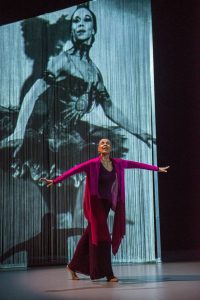It’s the opposite of the tree falling in the forest: if a performance is happening in a digital archive and someone is there to access and watch it, is the performance really over?

In his Middlebury College visit as part of the Dance Department’s Movement Matters series, Jacob’s Pillow Director of Preservation Norton Owen brought us to this question. Sharing the remarkable collection of digitized material in Jacob’s Pillow Interactive, curated online using a customized WordPress platform, Owen let us take in examples from the archive such as a 1936 film of Jacob’s Pillow founder Ted Shawn’s company, Men Dancers, performing Finale From the New World. With Antonín Dvořák’s composition, performed by the Philadelphia Orchestra and resynchronized in 2011 by Daniel Callahan, the piece took on an immediacy even as it simultaneously appeared in black and white, from another era. Owen pointed out that we view it differently now, when norms of sexuality both in and beyond dance world have changed radically. Do we see the same thing, even, that audiences saw when the film was made? The digital medium gives access not only to the historical artifact, but also to these epistemological and phenomenological questions. It’s a joy to watch in of itself; it’s full of information about the past; the digital curation, however, also makes it a new performance, at once in the flow of time and leaping out of it.
This was even more the case with another example Owens offered, Carmen de Lavallade performing As I Remember It in 2014, in which the dancer, now an older woman, performs in mirror-like reflections to herself in film footage of an earlier performance, Portrait of Billie (John Butler’s 1960 piece). We see, by way of our own computer screens, a video of a dancer dancing in front of a video of a dance, each performance and viewing experience layered across time in some sense in an infinite regress into the past, but also just as much in an infinite progress into the future.

Change and continuity, time ago and time now and time to come: the digital archive of performance does funny things. Most of all it deepens what we might mean by the term “access” when it comes to history, and particularly history of performance. Jacob’s Pillow Interactive is of course about a place—a kind of “dance utopia” as Norton Owen playfully called it at one point. But the digital archive also becomes something else: a floating, asynchronous festival of synchronized movement, one filled with Themes and Essays, Dance Playlists, and even a Guess section in which you can test your dance knowledge.
It is ebullient and fun, but also serious business, time travel of a sort, an orbit of glimmering views. It takes one to a portable, almost celestial palace of choreography that offers not only access to a trove of dance history, but also entrée into what it means to experience dance itself, performed in media res, across temporalities and spaces of movement that have been encapsulated—and then unleashed into the connected universe.